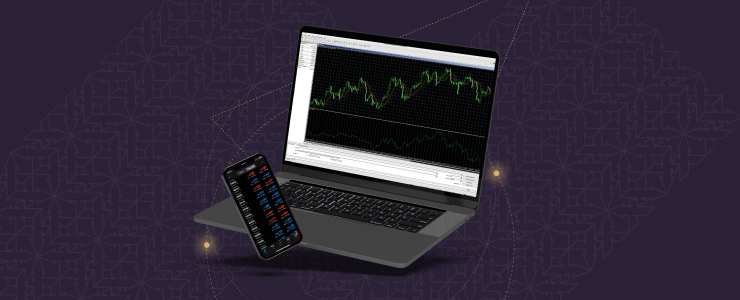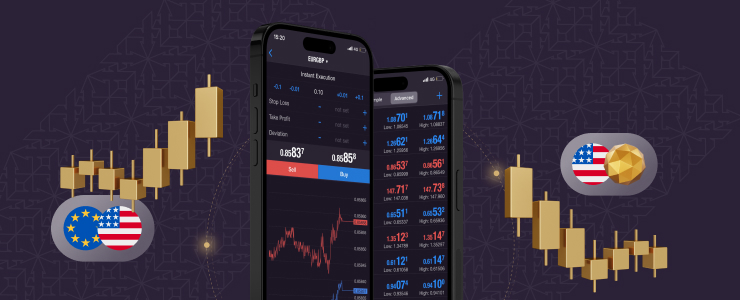Der CFD-Handel ist eine Form der Marktspekulation, bei der ein Händler einen Vertrag mit einem Broker abschließt, anstatt einen Vermögenswert zu kaufen. Im Gegensatz zu traditionellen Investitionen besitzen die Händler den Vermögenswert, auf den sie spekulieren, nicht und sie haben keinen direkten Einfluss auf die Märkte.
Damit wäre die Frage in unserer Überschrift beantwortet. Für neue Trader reicht diese Erklärung jedoch nicht aus. Sie fragen sich vielleicht, was für eine Art von Vertrag gebildet wird, wie Händler profitieren können, ohne Vermögenswerte zu besitzen, oder wie sie auf den Märkten handeln können, ohne die Kurse zu beeinflussen. Vielleicht sind Sie auch schon etwas fortgeschrittener und fragen sich, wo und wie Sie CFDs handeln können. All das und noch viel mehr werden wir in diesem Artikel beantworten, um Ihnen zu helfen, mehr über CFDs zu erfahren und eine gute Grundlage für Ihr Handelswissen zu schaffen.
Handel ohne Eigentum: Der zugrundeliegende Mechanismus des Handels mit CFDs
Wenn Sie eine Erklärung wie die im ersten Absatz unseres Artikels lesen, sind Sie vielleicht etwas eingeschüchtert, weil es sich unverständlich anhört. Das Eigentum an den zugrunde liegenden Vermögenswerten und die Verträge klingen recht formal, aber das gesamte Konzept ist einfach.
CFD ist die Abkürzung für Contract for Difference. Im Wesentlichen handelt es sich um einen Vertrag, dessen Preis an einen bestehenden Vermögenswert auf dem Markt gebunden ist. Beim traditionellen Handel würden Sie also eine Meta-Aktie kaufen und beim CFD-Handel einen Meta-Aktien-CFD. Die Preise sind natürlich nahezu identisch.
Der Unterschied besteht darin, dass Sie beim Kauf von Aktien auf den traditionellen Märkten einen tatsächlichen Anteil an dem Unternehmen besitzen würden. Sie kaufen aus dem begrenzten Aktienbestand des Unternehmens und beeinflussen so den Marktpreis, und wenn Sie genug kaufen, können Sie Mitglied des Vorstands werden.
Beim CFD-Handel kaufen Sie einen Vertrag mit Ihrem Broker. Das bedeutet, dass Sie keine Verbindung zum tatsächlichen Markt haben, den Preis nicht direkt beeinflussen und keinen Einfluss auf Angebot und Nachfrage haben. Ihr Broker wird jedoch höchstwahrscheinlich dafür sorgen, dass die Preise nahezu identisch mit dem tatsächlichen Markt sind. Daher sind die Unterschiede zwischen dem CFD-Handel und dem traditionellen Handel funktional gesehen vernachlässigbar, es sei denn, Sie kaufen eine große Anzahl von Aktien.

Handelsbeispiele
Um den CFD-Handel zu verstehen, werfen wir einen Blick darauf, wie ein traditioneller Trade aussehen würde:
- Sie nutzen einen Broker, um sich mit dem Markt zu verbinden.
- Sie kaufen einen Vermögenswert auf dem Markt.
- Sie sind nun Eigentümer des Vermögenswerts – wenn Sie z. B. genügend Aktien kaufen, können Sie sogar Vorstandsmitglied werden oder einen bedeutenden Anteil an dem Unternehmen besitzen.
- Sie können den Vermögenswert verkaufen, wann immer Sie wollen.
Und bei einem CFD-Trade:
- Sie nutzen einen Broker, um auf dessen CFD-Anlagenbibliothek zuzugreifen.
- Sie kaufen einen Kontrakt bei dem Broker.
- Sie können den Vertrag nach Belieben ausführen.
Es stellt sich natürlich die Frage, warum jemand mit CFDs statt mit traditionellen Vermögenswerten handeln sollte. Wenn der einzige Unterschied darin besteht, dass Sie den Gegenstand, den Sie kaufen, besitzen, warum sollten Sie sich dann nicht für den traditionellen Handel entscheiden? Und während es beim eigentlichen Handelsprozess keinen nennenswerten Unterschied gibt, sind viele Dinge im Umfeld von CFDs einfacher, leichter zugänglich oder vorteilhafter.
Warum Trader CFDs wählen
Der Hauptgrund, warum sich die meisten Händler für CFDs entscheiden, ist, dass sie viel zugänglicher sind. Beim traditionellen Handel läuft alles, was Sie tun, über Institutionen, die Börsen genannt werden, und die meisten lassen Sie nur auf inländische Produkte zugreifen. Für einen Nicht-US-Bürger könnte der Kauf der erwähnten Amazon-Aktie also bedeuten, dass er einige Hürden überwinden muss.
CFD-Broker hingegen sind meist von überall aus zugänglich. Sie brauchen nur Ihre Handelsplattform zu öffnen, und schon haben Sie Zugang zu den wichtigsten globalen Vermögenswerten. Für viele Händler sind diese Broker die einzige Möglichkeit, Zugang zu den besten Handelsinstrumenten zu erhalten.
Ähnlich verhält es sich mit dem traditionellen Handel auf internationalen Märkten, bei dem oft zusätzliche Gebühren anfallen. Dies kann dazu führen, dass die Preise wesentlich höher sind als beim Zugriff auf denselben Vermögenswert über CFDs. Der CFD-Handel bietet in der Regel eine Spread-basierte Struktur, die für die meisten Händler billiger ist.
Der nächste Punkt ist die Bequemlichkeit. Wenn Sie traditionell handeln, bietet Ihr Broker in der Regel nur eine oder höchstens ein paar Anlageklassen an. CFD-Broker haben in der Regel eine ganze Reihe von Vermögenswerten im Angebot – Devisen, Aktien, Indizes, Rohstoffe und vielleicht noch mehr – und ermöglichen es Ihnen, Ihr Portfolio zu diversifizieren und gleichzeitig alle Ihre Vermögenswerte in einem einzigen Bereich zu halten. Dies ist nicht nur aus Sicht der Benutzerfreundlichkeit bequemer, sondern macht auch die Analyse des Portfolios und der Handelshistorie viel einfacher.
Schließlich ist die CFD-Broker-Branche sehr wettbewerbsintensiv und zwingt die Broker zu Wachstum und Innovation. So sind beispielsweise Funktionen wie islamische Konten und Social Trading bei traditionellen Brokern nur selten verfügbar, aber bei Xlence können Sie darauf zugreifen. Daher empfinden Händler die Nutzung insgesamt als vielseitiger und komfortabler.

Warum Trader sich nicht für CFDs entscheiden sollten
Um völlig unvoreingenommen zu bleiben, müssen wir auch darlegen, warum manche von CFDs Abstand nehmen wollen. Der erste Grund ist, dass manche einfach nur Eigentum an einem Vermögenswert haben wollen. Wenn Sie ein Großaktionär werden oder von Dividenden profitieren wollen, ist der traditionelle Handel definitiv die bessere Option. Wenn Sie sich jedoch in diesem Stadium Ihrer Handelskarriere befinden, wetten wir, dass Ihr Wissen bereits über diesen Artikel hinausgeht.
Ein weiteres Problem ist, dass der CFD-Bereich gefährlich sein kann. Es gibt schlechte Akteure, die unerfahrene Händler ausnutzen und mit Betrügereien davonkommen. Wenn Sie jedoch die allgemeinen Sicherheitsregeln für das Internet befolgen, sich zunächst an beliebte Optionen halten und Versprechungen vermeiden, die zu gut klingen, um wahr zu sein, haben Sie nicht viel zu befürchten.
Welche CFDs können Sie handeln?
Alles, was Sie auf traditionellen Märkten kaufen können, können Sie auch als CFDs kaufen. Einige der beliebtesten CFDs sind:
- Aktien: Aktien von globalen Unternehmen
- Indizes: Aktiensammlungen, die Marktsegmente und nicht einzelne Unternehmen bewerten
- Rohstoffe: Konsum- und Industriegüter, oft unterteilt in drei Kategorien (Metalle, Energie, Landwirtschaft)
In den allermeisten Fällen finden Sie bei CFD-Brokern auch Devisenwerte. Diese Kategorien decken den größten Teil des Marktes ab, wobei einige Broker noch darüber hinausgehen. Bei Xlence zum Beispiel können Sie auch auf Futures zugreifen.
Wo Sie CFDs handeln können
Da Sie den Weg zu unserem Blog gefunden haben, ist Xlence eine gute Möglichkeit, um auf CFDs für alle genannten Märkte zuzugreifen. Vielleicht möchten Sie aber auch andere Optionen prüfen. Wenn Sie einfach nach „Country CFD Broker“ für Ihr eigenes Land suchen, werden Sie wahrscheinlich eine Menge Ergebnisse erhalten.
Einen Broker zu finden, der zu Ihnen als Anfänger passt, ist jedoch ein Prozess von Versuch und Irrtum. Zunächst einmal sollten Sie sich an bekannte Anbieter halten, die sowohl bei Nutzern als auch bei professionellen Anbietern einen guten Ruf genießen. Die Regulierung verringert außerdem die Wahrscheinlichkeit, dass Sie auf einen unehrlichen Broker stoßen.
Weitere Faktoren, die Sie berücksichtigen sollten, sind Spreads (je niedriger, desto besser), Kontooptionen, Plattform und Verfügbarkeit von Vermögenswerten. Die meisten dieser Faktoren hängen von Ihren persönlichen Vorlieben ab, und um Ihre Vorlieben herauszufinden, müssen Sie experimentieren.

Ihre erste CFD-Handelserfahrung
Bleiben noch die eigentlichen Schritte, die Sie unternehmen müssen, wenn Sie mit dem CFD-Handel beginnen. Für den Anfang werden Sie wahrscheinlich mit einem Demokonto handeln wollen. Suchen Sie sich dazu einen Broker, der ein Demokonto anbietet. Danach können Sie sich höchstwahrscheinlich mit einigen einfachen persönlichen Angaben registrieren und erhalten Ihre Anmeldedaten, um auf einer Testplattform mit virtuellen Geldern zu handeln. Diese Gelder können nicht abgehoben werden, sie sind also nur zum Üben da.
Sobald Sie mit dem eigentlichen Handel beginnen, wird Ihr Broker Sie wahrscheinlich auffordern, ein KYC-Verfahren zu durchlaufen. Dies ist Teil der Sorgfaltspflicht und kann Fotos Ihres Personalausweises und Rechnungen als Nachweis Ihres Wohnsitzes erfordern. Bedenken Sie, dass dieser Prozess einige Tage dauern kann.
Und das war’s; Sie sind dann offiziell ein CFD-Händler! Das Verfahren ist, wenn man es in kleinere Schritte zerlegt, recht einfach und nicht annähernd so beängstigend wie die Lektüre von komplexen Finanzkonzepten in der Theorie. Und während der Handel eine Sache der ständigen Selbstverbesserung ist, ist der erste Schritt ein großer, und wir hoffen, dass dieser Artikel Ihnen geholfen hat, Ihren zu machen!
Haftungsausschluss:Diese Informationen stellen keine Anlageberatung oder Anlageempfehlung dar, sondern sind eine Marketingmitteilung.




